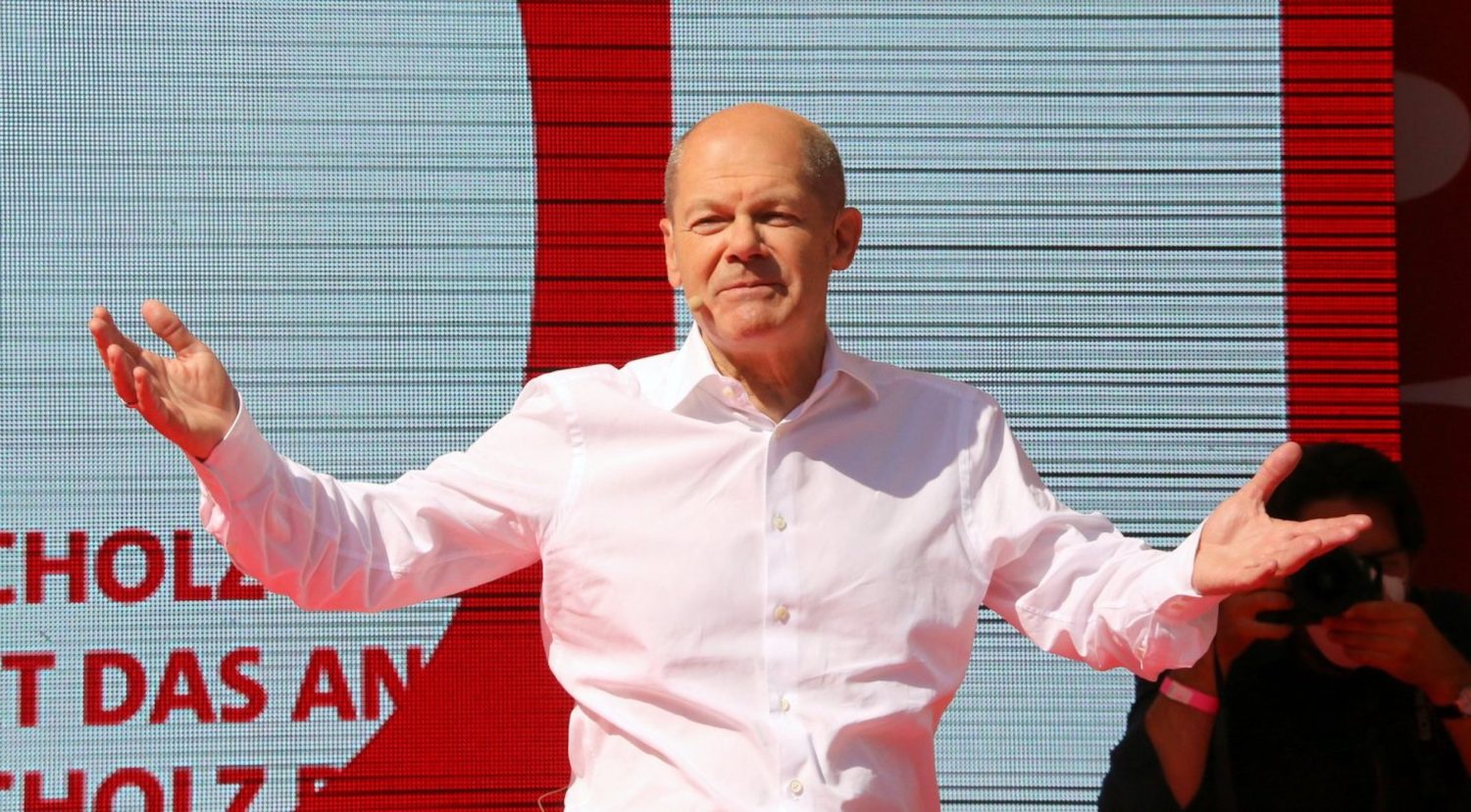Phoenix from the ashes
Not so long ago, there were fears that Germany’s SPD faced electoral wipeout – but now its candidate has become chancellor. Ed Turner and Davide Vampa chart the party’s road from despair to victory and consider whether it holds lessons for Labour
Roll the clock back to early June 2019, when an emotional leader of Germany’s social democratic SPD, Andrea Nahles, announced her resignation. The party had received just 15.8 per cent of the popular vote in the European elections in late May, the worst result in a national election in its history. This came on the back of some miserable results in state elections (under 10 per cent in Bavaria in 2018, under 20 per cent in Hesse, a state the SPD had governed for much of the post-war period), and morale was at rock bottom. At the 2017 federal election, the party got its worst result in its history (20.5 per cent), yet found itself once again entering the federal government as junior coalition partner to Angela Merkel’s Christian Democrats – a move actively opposed by a third of members, and agreed to only through gritted teeth by many more.
The SPD’s progress after 2017 seemed to follow the same pattern as in previous grand coalitions under Merkel: it would be able to push through large parts of its policy agenda, such as more rights for those in precarious employment, reduced health insurance contributions and taxes for those on lower incomes, and an increase in minimum pension levels. However, it got scant credit from voters, with the star of the Greens in opposition appearing to shine particularly brightly.
Among academics and think tankers concerned with social democracy, the debate was not so much whether the SPD could recover, but rather whether it would disappear from the scene completely (so-called PASOKification), or by virtue of its continued strength in some regions, bump along at the bottom of the polls. In particular, the ‘crisis of social democracy’ narrative, positing that social democratic parties were unable to unify an increasingly diverse potential support base, gained ground. How, it was asked, could social democrats appeal at the same time to liberal, well-educated voters concerned about the environment and tempted by the Greens, and to more socially conservative, working-class voters concerned about the risks of a transition to a low carbon economy?
Fast forward to September 2021, and the transformation in the party’s fortunes appears remarkable: a gently smiling Olaf Scholz, the SPD’s chancellor candidate has topped the poll (albeit with just 25.7 per cent – reflecting the fragmentation of Germany’s party politics) and embarks on the negotiations which will see him take over from Angela Merkel as chancellor. How can we explain the turnaround in the party’s fortunes? There are three aspects that we discuss here: sound strategic choices, fortunate circumstances, and also the importance of not overstating the extent of the party’s success.
We have been investigating the SPD’s electoral performance at the regional level in Germany since reunification in 1990, and have analysed election results, manifesto data, and data about party organisation and incumbency (an analysis of 113 manifestos and sets of election results). Our findings help explain the SPD’s success in 2021 in two ways. Firstly, the SPD seems to get better election results when it stands on a more left-wing platform. In the 2021 election, the party moved somewhat to the left: an important aspect of Andrea Nahles’ legacy as leader was that the SPD coalesced around a social policy agenda that departed from the Hartz reforms – the package of welfare cuts introduced under SPD chancellor Gerhard Schröder in the early 2000s. The Hartz reforms led to substantial reductions in support for the unemployed, and the party paid a heavy price in terms of party unity and electoral support from those affected. In the 2021 manifesto, the leitmotif was ‘respect’ – for all in society, especially those in caring professions and other key workers, with measures proposed to improve their pay and conditions. The SPD pledged a substantial rise in the minimum wage to 12 euros per hour. Scholz’s own image shifted too: previously he had been perceived as a fiscal hawk, and in his early years as the SPD’s federal finance minister he seemed to have an unwavering commitment to balanced budgets. The pandemic changed all that: he became associated with a ‘big bazooka’ of measures to support and revive the German economy, and led the way in developing the EU’s fiscal response through its recovery fund.
Secondly, in state elections we find that party organisation matters, and specifically that levels of party membership make a difference to electoral support. Whereas the SPD’s 2017 election campaign was characterised by some major organisational missteps (explored in an independent report the party commissioned bluntly entitled Learning from Mistakes). By contrast, in 2021 it made a real effort to engage its members, co-ordinate its campaign putting Scholz at the centre, raise its social media profile, and commission effective advertising.
The third lessons from state elections, though, is that the SPD does best when it is leading the government; it does worst when it is the junior partner in a coalition government, with results from opposition landing somewhere in between. This finding – that being a junior coalition partner is politically difficult – chimes with the SPD’s experience in government nationally, and explains the party’s reluctance to re-enter government in this role for the 2017–2021 period. We also know that there seems to be a significant, and related, incumbency bonus in state elections: popular minister presidents can give a real boost to their parties (something that the SPD repeatedly found when the chips were down, most recently in Rhineland Palatinate in 2021, when under Malu Dreyer, the SPD secured a triumphant victory well before the polls turned nationally in Scholz’s favour). Yet its success as junior coalition partner is something readily explained in the context of September 2021: Angela Merkel was not restanding as chancellor, so the Christian Democrats failed to secure the incumbency bonus which they would otherwise have received, and instead Olaf Scholz, as vice chancellor and finance minister, was able to profit. In the days when the SPD was in the doldrums, party officials repeatedly told us that their last hope was that, when German voters finally realised Angela Merkel was not re-standing, they would take a closer look at Scholz, as a popular and effective incumbent finance minister. And so it proved.
This takes us to the more contingent factors leading to the SPD’s victory. Three are particularly worthy of mention. The first was the implosion of the Christian Democrats. Eventually, the minister president of North Rhine Westphalia was installed as chancellor candidate (having narrowly secured the CDU’s leadership). Laschet had not had a good pandemic, his poll ratings were poor, and he was made to fight all the way for the nomination by the Bavarian minister president Markus Söder, leader of the CDU’s sister party in Bavaria, the CSU. The campaign was not kind to Laschet: he was caught on camera laughing with party colleagues while the federal president made a speech in the immediate aftermath of flooding in Laschet’s state; he apologised but the damage was done. He was accused of plagiarism, struggled to name three priorities for a government he would lead, and Söder carped from the sidelines, conveying a strong sense of disunity.
Second, the Greens did not cope well with the pressure of the short campaign, with their candidate Annalena Baerbock accused of embellishing her CV, not declaring all her income, and also of plagiarism. Third, the SPD’s unusual structure in 2021 seemed to serve it well. In 2019, Olaf Scholz and his running mate Klara Geywitz lost a vote for the party’s leadership to two relatively unknown left-wing candidates. Yet these leaders, Norbert Walter-Borjans and Saskia Esken, shored up the party’s left flank, and meant in 2021 it was uncharacteristically united, rather than squabbling over its direction.
We should not, however, overstate the party’s success. Severe challenges remain, perhaps hinting that some of the underlying structural issues leading to that ‘crisis of social democracy’ are not completely solved. In particular, while the SPD did disproportionately well amongst older voters (32 per cent amongst those aged 60–69, 35 per cent amongst the over 70s), it fared worse amongst younger voters (15 per cent amongst the 18–24s, 17 per cent for 25–34 year olds). After the televised debates, too, it was striking that Scholz was perceived far more favourably amongst older than younger voters, for whom the Green candidate Baerbock was more attractive. Scholz’s projection as a serious, competent, experienced politician (trading on his ‘Hanseatic’, north German, lack of flamboyance) resonated with older voters (many of whom previously voted for Merkel). That was helped by the CDU’s chaotic appearance, but the SPD has not completely cracked the puzzle of how to appeal across society. This was confirmed by polls published immediately after the elections showing that while the SPD gained 1.5 million votes from the CDU (by far the largest swing), it continued to leak votes to the Greens. So while topping the poll and taking the chancellery in 2021 is a remarkable achievement, we should bear in mind that the same vote share – 25.7 per cent – had translated into a clear defeat back in 2013 and was a long way off the successes of the late 1990s, when Gerhard Schröder got more than 40 per cent of the vote.
Another key aspect was the geography of the vote. Since 2005, the SPD has experienced significant decline in the poorer regions of eastern Germany. These have traditionally been characterised by a competitive (and unstable) party system. The rise of the Left Party (a descendent of the East German Community Party) was significant, and the far right Alternative for Germany also became particularly established in the east. Between 2005 and 2017, the SPD’s support fell by 18 per cent in eastern Germany, compared to a decline of 13 per cent in the West. This slump was representative of a general European trend, which saw social democratic parties struggling in more peripheral, ‘left-behind’ areas. The 2021 federal election marked a clear reversal of this trend. The party’s share of the vote in eastern Germany jumped by 10 percentage points, more than doubling its electoral growth in the West (4.1 per cent). According to the polls mentioned above, the SPD regained 640,000 votes from the Left Party and 260,000 from AfD. For the first time since Schröder’s last victory, Scholz’s SPD seems to have benefited from east Germans’ weaker party allegiances and their readiness to switch vote. The vacuum left by Merkel and immediately occupied by Scholz, combined with the role played by some strong local leaders, had a positive impact on the SPD’s performance.
Are there any lessons for Labour here? Undoubtedly so, and they should offer some encouragement. The SPD’s results show that voters welcome a serious, competent leader. They indicate that a more left-wing programme can have traction (though to be clear, this is more Labour in 2015 than 2019 – Olaf Scholz is no Corbynista), and that party members and strong organisation can make a real difference. They also show that social democratic decline in less economically dynamic regions is not irreversible: pragmatism in response to competitors’ mistakes, combined with strong local leadership, may even trump populist appeals to the so-called ‘losers of globalisation’.
Yet perhaps the most important lesson is that a party looking in an impossible structural position should not give up: the SPD’s turnaround happened late (the party only overtook the CDU/CSU a month before the election, and had been in third place, at around 15 per cent, in late July).
There is a German saying “hope dies last” and in an era of volatile, fragmented party politics, the German SPD, with a mixture of good judgement and good fortune, showed that there can be a road to social democratic recovery from the most difficult circumstances.
Image credit: Michael Lucan/Wikimedia


